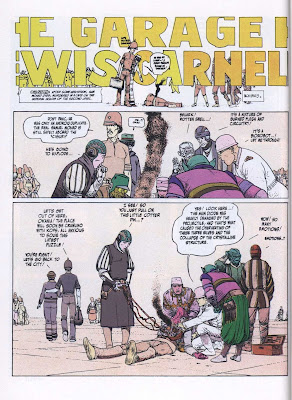by Lucius Shepard (writer) and Al Davison, John Totleben, and Gary Erskine (art)
DC / Helix, 1996 - 1997
In 1996, DC launched a new imprint, called 'Helix', designed to showcase sf comics. It was an effort to try and capture an older, more discerning readership in the manner of the Vertigo line, which by '96 was well established and one of the more profitable enterprises in the DC lineup.
Unfortunately, even though the Great Comic Book Crash of '93 was three years gone, the industry still was deep in the doldrums, and the Helix line was cancelled in 1998. It turned out that most sf readers weren't all that entranced with the Helix titles, and the regular comic book readership was not all that interested in the material, either.
That said, one of the more intriguing titles in the Helix line was Vermillion, created in partnership with Lucius Shepard (1943 - 2014), one of the 'first generation' cyberpunk authors whose first novel Green Eyes (1984) was among the novels selected for the influential Ace Science Fiction Specials series of the mid-80s.
Vermillion - the name refers to a city the size of the solar system, in which most of the story takes place - mixed sf and fantasy with the occasional horror segment.
The lead character is one Jonathan Cave, an antihero. His origin is never explained, but he is presented as a self-centered, affectless individual who - as the narrative progresses - discovers he possesses unique abilities, among them the ability to recognize aliens masquerading as humans.
The series had two major story arcs; in the first arc, issue 1 - 7, Cave finds himself aboard a massive starship, whose crew seeks to remake the universe with the aid of a supercomputer. Issue 8 is a standalone episode, and issues 9 - 11 deal with Cave's interactions with one of the Ilumi' nati, the race of aliens who secretly control the workings of the universe. Issue 12 is a standalone wrapup for the series.
One of the things that Vermillion does right is to have talented artists on its roster; Davison, in particular, provides meticulous artwork that showcases all manner of atmospheric settings and intricate architectural details, as well as embellishing many panels with little in-jokes and easter eggs. Davison also is skilled at drawing monsters, varieties of which are plentiful in the initial story arc.
Where Vermillion falls short is the scripting; not surprisingly, Shepard has a tendency to overwrite..........and too often the plot is subordinated to lengthy passages of dialogue and introspection, which in turn crowd out the artwork with excessive speech balloons and text boxes. Add in Shepard's determination to give the proceedings a phantasmagorical, metaphysical atmosphere, and Vermillion frequently gets more than a little self-indulgent.
Despite the problems with the script, Vermillion has some strong moments, particularly in issue 7, in which Jonathan Cave, seeking vengeance, infiltrates the home ground of one of the more unpleasant Ilumi' nati. Shepard makes this episode a horror story rather than sf or fantasy, and Davison's artwork is more than up to the task.
Issue 8 - which I've posted in its entirety here - is another high point of the series.
Summing up, Vermillion has enough high points to make it one of the more interesting attempts by a sf author to write a comic book series. Fans of Lucius Shepard's work likely will want to get the series, and comic book readers willing to take a chance on a more offbeat title, one endowed with very good artwork, may find Vermillion rewarding as well.
The series has not been collected into a graphic novel, but full sets can be obtained from eBay for about $20.




























































.jpg)























